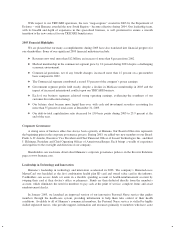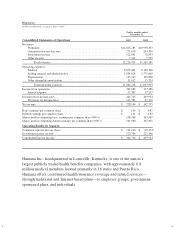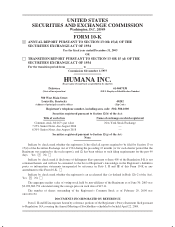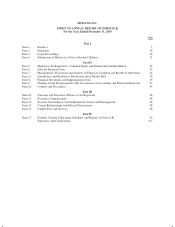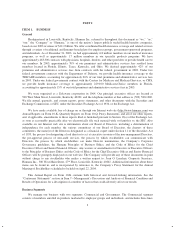Humana 2003 Annual Report Download - page 16
Download and view the complete annual report
Please find page 16 of the 2003 Humana annual report below. You can navigate through the pages in the report by either clicking on the pages listed below, or by using the keyword search tool below to find specific information within the annual report.
On August 21, 2003, the Department of Defense notified us that we were awarded the contract for the South
Region, one of three newly-created regions under the government’s revised TRICARE Program. The current
TRICARE Regions 3 and 4 will become part of the new South Region along with Region 6, which is currently
administered by another contractor. The current Regions 2 and 5 will become part of the North Region, which
was awarded to another contractor.
Pursuant to the Department of Defense’s bid process, each of the three awards was subject to protests by
unsuccessful bidders of prime contracts, however, none of the protests were successful.
Under the Department of Defense’s current schedule for implementation of the new TRICARE contracts,
Regions 2 and 5 will transition to the new North Region for the start of healthcare delivery on July 1, 2004.
Regions 3 and 4 will become part of the new South Region for the start of healthcare delivery on August 1, 2004
and Region 6 will become part of our new South Region for the start of healthcare delivery on November 1,
2004. If this schedule is realized, our TRICARE membership is expected to temporarily decline to 1.5 million in
July 2004, and is expected to increase to 2.8 million in November 2004. This will also result in a decline in
revenues during this period.
In addition, retail pharmacy benefits for TRICARE beneficiaries will be administered separately under the
new Department of Defense TRICARE Retail Pharmacy Program. On September 26, 2003, we were notified that
we were not awarded the retail pharmacy contract and, later, that our protest of this award decision was not
upheld.
Currently, three health benefit options are available to TRICARE beneficiaries. In addition to a traditional
indemnity option, participants may enroll in an HMO-like plan with a point-of-service option or take advantage
of reduced copayments by using a network of preferred providers. We have subcontracted with third parties to
provide various administration and specialty services under the contracts. For the year ended December 31, 2003,
TRICARE premium revenues were approximately $2.2 billion, or 18.6% of our total premiums and ASO fees.
At December 31, 2003, we had 1,057,200 TRICARE ASO beneficiaries for which the Department of
Defense retains the risk of financing the cost of their health benefits. We obtained these beneficiaries from our
acquisition of Regions 2 and 5, and by enrollment in two government programs that allow senior beneficiaries to
continue in the TRICARE program even after becoming Medicare eligible, which normally is age 65. The first of
these programs, called TRICARE Senior Pharmacy, became effective April 1, 2001. Under this government
administrative services program, senior TRICARE beneficiaries receive certain pharmacy benefits not covered
under Medicare. On October 1, 2001, the TRICARE for Life program expanded coverage to include medical
benefits as well. For the year ended December 31, 2003, TRICARE administrative services fees totaled $148.8
million, or 1.2% of our total premiums and ASO fees. Once the Department of Defense’s new contracting
structure is implemented, our responsibility for both of these programs will cease. The TRICARE Senior
Pharmacy program is intended to become part of the previously mentioned TRICARE Retail Pharmacy Program.
The TRICARE for Life program will become the TRICARE Dual-Eligible Fiscal Intermediary Contract
(TDEFIC). The TDEFIC contract, for which we did not bid, was awarded to another contractor on July 25, 2003.
It will become effective when the current regional contracts expire.
We do not believe that these TRICARE contract changes occurring during 2004 will have a material adverse
effect on our financial position, results of operations, or cash flows.
8


